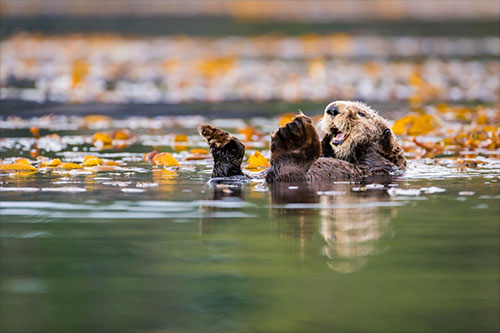
Recovery of sea otter populations yields more benefits than costsNew model puts dollar value on ecological transformations driven by otters
June 15, 2020
But the long-term benefits of sea otter recovery - such as healthier kelp forests, higher fish catches, carbon storage and tourism - could be worth as much as $53 million per year, according to new UBC research. If well-managed, these economic benefits could offset commercial losses to shellfish fisheries of $7 million per year.
The study, published last week in Science, is the first regional economic analysis of the costs and benefits of sea otter recovery along the west coast of Vancouver Island. Critically, it offers a new modeling framework to evaluate the significant long-term ecological changes driven by a top predator like the sea otter. "Our work offers a glimpse into a future where otter populations have recovered to an estimated 5000 animals, and have fully reoccupied their historic range," said lead author Edward Gregr, an adjunct professor at the Institute for Resources, Environment and Sustainability at UBC. "We found that coastal ecosystems with otters present are almost 40 per cent more productive. In the long run, that equates to higher fish catches worth $9 million, carbon storage worth $2 million and tourism opportunities worth $42 million per year." That's because the hungry otters drive huge transformations to their local ecosystems: by keeping urchin populations in check, they allow kelp forests to recover. Healthy kelp forests, in turn, sequester carbon and support abundant marine life, from salmon and lingcod to seals and whales. For the analysis, researchers integrated local ecological field studies with available economic data and a , and accounted for uncertainties in future values and potential interactions among the species in the coastal ecosystem. "It's clear that humanity must reverse the decline in biodiversity if we want to achieve a sustainable future," said co-author Kai Chan, a professor at IRES and the Institute for the Oceans and Fisheries at UBC. "This study demonstrates that restoring key species to ecosystems can also have great benefits for people, and could serve as a useful framework for evaluating top predator recovery elsewhere." But, the researchers warn, the costs and benefits of such large ecosystem reorganizations are often not equally distributed. In British Columbia, future management decisions must consider the implications for local Indigenous communities and fishers, who are experiencing the losses from shellfish fisheries more acutely. For example, while commercial fishers are likely to adapt to fewer crabs in shallow waters by fishing in deeper waters, Indigenous or recreational harvesters with more restricted access may not be able to. "Other costs and benefits - like food security, culture and tradition - are also considerable, but they are more difficult to value in dollars," said Gregr. "Going forward, we want to scale the model down and incorporate such impacts at the local level." The researchers hope that quantifying the impacts of ecological transformations more broadly will help mitigate conflicts, promote public acceptance of ecosystem change and help identify opportunities for local communities. "Sea otters co-existed with and were managed by the Indigenous Peoples of this region for millennia before they were hunted to near extinction by the maritime fur trade," said Gregr. "Their recovery is a golden opportunity for the Government of Canada to reconcile coastal fisheries management with local communities and regional stakeholders to ensure strong, healthy coastal communities and thriving otter populations."
On the Web:
Edited By Mary Kauffman, SitNews
Source of News:
|
||||
